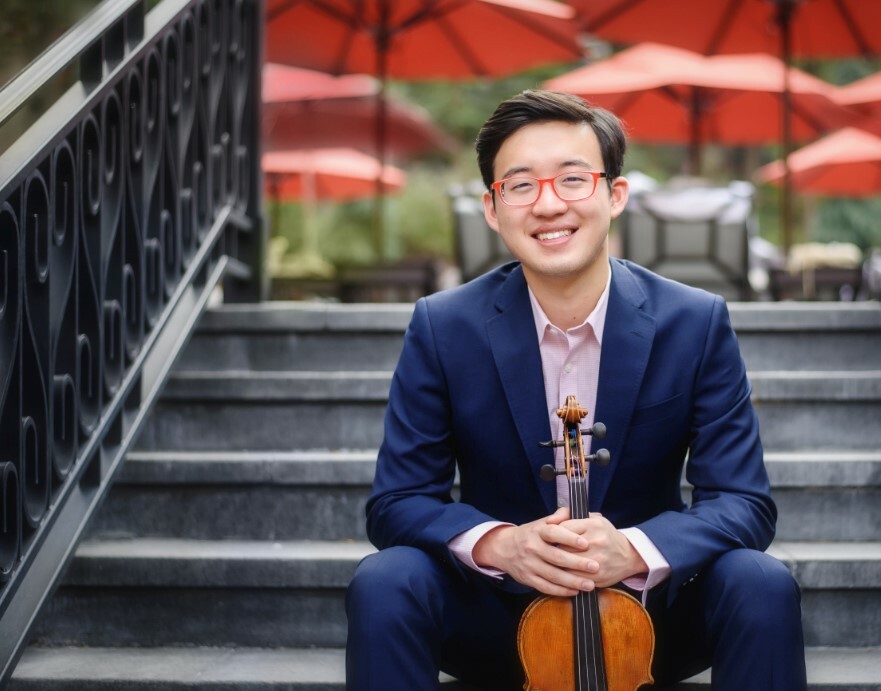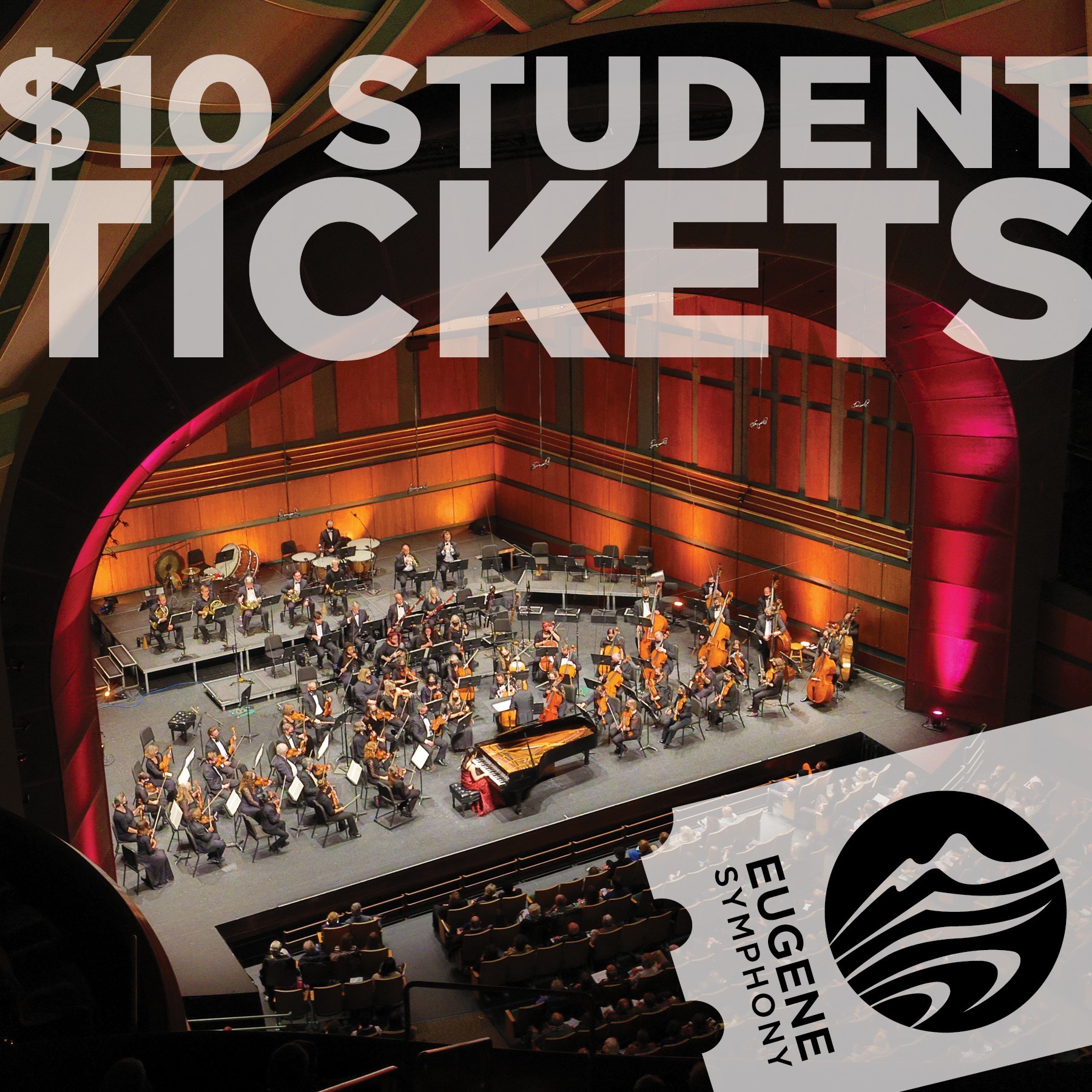Thu January 19 | 7:30 PM
Mozart’s
"Jupiter"
Early music expert Nicholas McGegan conducts a program highlighting 18th-century music. Featuring guest violinist Julian Rhee performing Mozart's "Turkish" Symphony.
TICKETSJanuary 19, 2023 7:30 PM
Mozart’s
"Jupiter"
Internationally renowned conductor and early music expert Nicholas McGegan leads the Eugene Symphony for the first time in a program of music from the 18th century. You’ll hear two revered works by the incomparable genius Wolfgang Amadeus Mozart, including his “Turkish” Violin Concerto played by rising star Julian Rhee and his joyful “Jupiter” Symphony. We also feature music by classical period Austrian composer Marianna Martines and a largely forgotten gem by Haydn.
Join us at 6:30 pm in the Studio at the Hult Center for our Guild Pre-Concert Talk. ESA Executive Director Scott Freck will moderate a conversation with guest conductor Nicholas McGegan and guest violinist Julian Rhee. Arrive early! This event tends to fill up.
LEARN MORE
- Listen to the below Spotify playlist, curated by Music Director & Conductor Francesco Lecce-Chong, for inspiration and insight into this timeless Mozart classic.
- Listen to the below podcast from Sticky Notes: The Classical Music Podcast, for a deeper dive into the context and history of Mozart's "Jupiter."
- Watch the below video of Music Director & Conductor Francesco Lecce-Chong introducing the exciting offerings of Mozart's "Jupiter."
- Read our First-Timers Guide to brush up on orchestra vocabulary and find out what to expect from a concert at the Hult Center
- Download our Digital Program Book for program notes
About Julian Rhee

Julian Rhee is quickly gaining recognition as an emerging artist and performer, praised for his "sophisticated, assured tone, superb intonation, and the kind of poise and showmanship that thrills audiences." (The Strad )
An avid soloist, Julian made his Milwaukee Symphony Orchestra debut at age 8, and has gone on to perform with orchestras such as the Santa Rosa Symphony, Pittsburgh Symphony, Aspen Philharmonic, Eugene Symphony, San Jose Chamber, Madison Symphony, Avanti Symphony, West Suburban Symphony, Wisconsin Philharmonic, Lacrosse Symphony, the Wisconsin Chamber, San Diego Symphony, among others. He has performed in an array of venues including Ravinia’s Bennett Gordon Hall, Heinz Hall, the Overture Center for the Arts, Teatro El Círculo in Rosario, Argentina, The Musikverein in Vienna, Bartok Hall in Hungary, New World Center, and the John F Kennedy Center as a US Presidential Scholar and received his medal at the White House. Recent and upcoming engagements include appearances at the Dame Myra Hess Memorial Concerts, East Coast Chamber Orchestra, Leonard Slatkin and the Indianapolis Symphony, Nicholas McGegan and the Eugene Symphony, athe Middleton, Bucks County, Brevard, Menomonee Falls, and Fresno Philharmonic Orchestras.
Julian is the Silver Medalist of The 11th Quadrennial International Violin Competition of Indianapolis, winner of Astral Artists’ National Auditions, and the first prize winner of the 2020 Elmar Oliveira International Competition, where he was also awarded the special Community Award.
A passionate chamber musician, Julian's performance on violin and viola earned him first prize in the Fischoff and the M-Prize Chamber Competitions. He has performed at and attended festivals including the Heifetz, Four Seasons, Ravinia Steans Institute, Rockport Music and Northshore Chamber Music Festivals. He has also appeared alongside Time for Three, Jupiter Chamber Players, 98.7 WFMT's Introductions, Milwaukee Public Television, and Wisconsin Public Radio and Television.
Julian studied with Hye -Sun Lee and Almita Vamos at the Music Institute of Chicago Academy. He is currently pursuing a Masters degree with Miriam Fried at the New England Conservatory.
Julian is the recipient of the outstanding 1699 "Lady Tennant " Antonio Stradivari violin on the extended loan through the generosity of the Mary B. Galvin Foundation and the efforts of the , a division of Bein & Fushi, Inc. The Mary B. Galvin Foundation, Inc. and the Stradivari Society support the very highest level of string playing by loaning precious antique Italian instruments to artists of exceptional talent and ability.
About Nicholas McGegan

In his sixth decade on the podium, Nic McGegan — long hailed as “one of the finest baroque conductors of his generation” (The Independent) and “an expert in 18th-century style” (The New Yorker) — is recognized for his probing and revelatory explorations of music of all periods. Following a 34-year tenure as Music Director of Philharmonia Baroque Orchestra and Chorale, he is now Music Director Laureate. He is also Principal Guest Conductor of Hungary’s Capella Savaria. At home in opera houses, McGegan shone new light on close to 20 Handel operas as the Artistic Director and conductor at Germany’s Göttingen Handel Festival for 20 years (1991-2001), and the Mozart canon as Principal Guest Conductor at Scottish Opera in the 1990s. He was also Principal Conductor of Sweden’s Drottningholm Court Theatre from 1993 to 1996.
Best known as a Baroque and Classical specialist, McGegan’s approach — intelligent, infused with joy, and never dogmatic, along with an ability to engage players and audiences alike — has made him a pioneer in broadening the reach of historically informed practice beyond the world of period ensembles to conventional symphonic forces.
McGegan’s prolific discography includes more than 100 releases spanning five decades. Having recorded over 50 albums of Handel, McGegan has explored the depths of the composer’s output with a dozen oratorios and close to 20 of his operas.
Mr. McGegan is committed to the next generation of musicians, frequently conducting and coaching students in residencies and engagements at Yale University, the Juilliard School, Harvard University, the Colburn School, Aspen Music Festival and School, Sarasota Music Festival, and the Music Academy of the West. He has been awarded the honorary degree of Doctor of Music by the San Francisco Conservatory of Music; an honorary professorship at Georg-August University, Göttingen; and in 2016 was the Christoph Wolff Distinguished Visiting Scholar at Harvard. McGegan’s fun and informative lectures have delighted audiences at Juilliard, Yale Center for British Arts, American Handel Society, and San Francisco Conservatory.
English-born, McGegan was educated at Cambridge and Oxford. He was made an Officer of the Most Excellent Order of the British Empire (OBE) “for services to music overseas.” Other awards include the Halle Handel Prize; the Order of Merit of the State of Lower Saxony (Germany); the Medal of Honour of the City of Göttingen; and a declaration of Nicholas McGegan Day by the Mayor of San Francisco, in recognition of his work with Philharmonia Baroque.
Mozart's "Jupiter' Program Notes

SINFONIA IN C MAJOR Marianna Martines (1744–1812)
DURATION: Approximately 12 minutes
Marianna Martines’s life and work is a perfect case study of the erasure often imposed upon women and people of underrepresented groups in the history of Western classical music. Those who were in her orbit are figures who loom large: composer Franz Joseph Haydn, the poet Metastasio, the Empress Maria Theresa, and her son Emperor Joseph II. Gender or power were factors in allowing their names and deeds to be widely remembered, a privilege Martines was not granted, despite the brilliance of her works.
Born in 1744, Martines was considered a prodigy from a very young age, excelling as a keyboard player, a singer, and as a composer. She was the first woman admitted to the Accademia Filarmonica in Bologna, Italy, a prestigious music institution that would contribute to the education of Mozart. She would achieve great acclaim as a composer and performer in the musical capital of the world, Vienna.
The Sinfonia in C Major is written in the classical Italian style popular amongst composers at the time due to the close musical relationships between the city of Vienna and Italian musical cities of Naples and Bologna. Composed in 1770, the work is laid in three movements in the fast-slow-fast structure of the time. The first movement struts and preens like a peacock, featuring bursts of virtuosic string lines. The second movement is a beautiful song-like slow movement that sounds like it should be sung by a soprano lamenting of lost love. The piece ends with a dancing third and final movement, bringing this charming work to an end.
SCORED: For two oboes, two horns, two trumpets, and strings.
HISTORY: This is the first Eugene Symphony performance.
VIOLIN CONCERTO NO. 5 IN A MAJOR, K. 219 “TURKISH” Wolfgang Amadeus Mozart (1756–1791)
DURATION: Approximately 31 minutes
As a performer, Wolfgang Amadeus Mozart truly shined at the keyboard, performing often and known throughout Vienna and Europe at large for his technical capabilities. In addition to his skill at the piano was his ability as a string player, on both violin and viola, cultivated by early training by his father, Leopold Mozart. At the time of Wolfgang’s birth in 1756, the senior Mozart was one of the leading violin teachers in the city of Salzburg and would shortly author A Treatise on the Fundamentals of Violin Playing, a document that would influence future generations of violinists for years to come. Leopold himself, who was sparing in his praise of his son, once wrote to Wolfgang, “You yourself do not know how well you play the violin… when you play with energy and with your whole heart and soul, yes, indeed, just as though you were the first violinist in all of Europe.”
The A-Major Violin Concerto is the fifth amongst the five violin concertos written by Mozart, all composed in a single year in 1775 when Mozart was 19. Of the five, it is the most original, most unconventional, and most Mozartean in its spirit of joy and lyrical beauty. The work is laid out in the traditional three-movement concerto form.
The first movement begins with a breathless orchestral introduction, with trembling strings and a sparkling rising figure. The orchestra builds to a dramatic height, ready to open the curtain for the soloist. Here, Mozart breaks convention—rather than jumping onto the train set in motion by the orchestra, the violin soloist interrupts the building of excitement in favor of a songful slow entrance, singing in operatic fashion with a soaring theme that never returns. This moment in the piece is unique and would have greatly surprised audiences of the time. The soloist then plunges into the fast section of the movement, dazzling with virtuosity and conversing excitedly with the rest of the ensemble.
The second movement is lyrical and gentle, sometimes wandering into areas of darkness and poignancy. At its climax, the music is heartbreakingly gorgeous. In a work composed at the young age of 19, Mozart foreshadows the sublimity he will achieve in his later operas.
The third and final movement is a Rondo, a form in which the movement constantly returns to the quaint melody introduced at the beginning, with sections between each iteration developing the theme. One of the sections features a gypsy dance in a minor key, a startling musical area that features cellos and basses hitting their strings with the wood of their bow, a style that gives the concerto its name “Turkish.” The movement comes to a cheeky and quaint conclusion, with the first violin ascending quietly and disappearing into the stratosphere.
SCORED: In addition to the solo violin, scored for two oboes, two horns, and strings.
HISTORY: First performed by the Eugene Symphony in January 2006 under the direction of Giancarlo Guerrero and with Martin Chalifour as soloist.
OVERTURE TO L’ISOLA DISABITATA (THE DESERT ISLAND) Franz Joseph Haydn (1732–1809)
DURATION: Approximately eight minutes
One of the most overlooked factors in a composer’s ability to create music is economics: Can the composer devote enough time to their craft and still be able to make a living? Many composers struggled to achieve this balance, with many of the greatest names in Western classical music living frugally or in outright poverty.
Austrian composer Franz Joseph Haydn was lucky in this respect—he spent more than five decades as the Kapellmeister in the court of the Esterhazy family, composing and performing for the wealthy and influential nobles, wanting for nothing. It was this freedom that allowed him to fully channel his creativity, gain international fame, and eventually lead him to be called “Father of the Symphony” and “Father of the String Quartet.”
While in the service of the Esterhazys, Haydn composed for many mediums, including 14 operas, amongst them The Desert Island. The Overture to the opera was composed in 1789 and is in the style of Sturm und Drang (Storm and Stress), a German literary and artistic movement in the late 18th-century characterized by extreme emotion and a fiery ethos, a precursor to the 19th-century Romantic period.
The Overture begins with a mournful introduction, with the entire orchestra playing unison figures before a quiet theme in the strings. Then comes a dramatic and turbulent fast section, with singing upper strings and pounding lower strings. Without warning, the drama is swept aside for a jarringly quaint dance. The digression is short, and we soon return to the blazing fast material, unrelenting to the work’s final notes.
SCORED: For one flute, two oboes, one bassoon, two horns, two trumpets, timpani, and strings.
HISTORY: This is the first Eugene Symphony performance
SYMPHONY NO. 41 IN C MAJOR, K. 551 “JUPITER” Wolfgang Amadeus Mozart (1756–1791)
DURATION: Approximately 31 minutes
In a cultural landscape today filled with stories of multiverses and alternate dimensions, a favorite reality for lovers of classical music to imagine is one in which Wolfgang Amadeus Mozart was allowed to live a full life. The greatest driving factor behind this fantasy is that the composer passed away at the young age of 36 at the peak of his powers. In the final five years of his life, he produced his greatest works, including the operas The Marriage of Figaro, Don Giovanni, Così fan tutte, and The Magic Flute, the final five piano concertos, the final four symphonies, and his unfinished Requiem mass. Every one of these pieces are viewed as astounding feats of technical and emotional creativity.
Mozart’s final three symphonies, No. 39, No. 40, and No. 41, were composed in the span of a remarkable nine weeks in 1788. Each symphony is unique from the other in structure and in character. Symphony No. 41 is the most grand and sweeping in scope of the three, for which it would later earn the nickname “Jupiter,” for the Roman king of the gods.
The first movement begins with three ascending gestures, played in unison by the entire orchestra. Immediately following is a sweet, lilting figure in the violins. These two ideas will serve as the foundation for the entire movement. The movement is complex, but Mozart balances the interweaving lines with a mastery matched by few.
The second movement is slow and singing, a beautiful aria that features the first violins, oboe, and flute. The strings are instructed to put mutes on their instruments, giving the whole second movement a dreamy, distant, and warm quality.
The short third movement begins with a courtly and regal dance. The middle section features a friendly conversation between the woodwinds and strings.
The fourth and final movement, Mozart’s last symphonic movement, is particularly unusual in that he chose to feature the compositional technique of counterpoint, the interweaving of musical lines independent of one another. This technique, extremely difficult to execute, was popular amongst composers during the Baroque era and was seen as outdated by Mozart’s time. The violins introduce the floating but energetic main theme before the entire orchestra excitedly joins in. Throughout the entire movement, different sections of the orchestra trade musical lines and motifs in a manner reminiscent of fencers quickly trading blows.
Mozart saves the best for last: the final section of the movement features a section of five independent melodic lines he has introduced during the course of the symphony, playing simultaneously in a dazzling display of compositional prowess. With this symphony, Mozart grins confidently and winks at us, saying, “Look what I can do.”
SCORED: For one flute, two oboes, two bassoons, two horns, two trumpets, timpani, and strings.
HISTORY: First performed by Eugene Symphony in November 2008 under the direction of Giancarlo Guerrero and last performed in November 2014 under the direction of Pavel Baleff
Enter the Eugene Symphony Lottery!
Are you feeling lucky? Enter the Eugene Symphony lottery for the chance to win two tickets to an upcoming concert! Fill out this form, including contact information and choose from a variety of our symphonic concerts that you would like to attend. If you are a winner, you will be contacted one week before the concert to collect your winnings.
Health & Safety
The health and safety of Eugene Symphony audience members, musicians, and staff members has been and will always be our top priority. We strongly welcome and encourage patrons who wish to continue wearing masks while attending performances to do so. We want all of our attendees to feel comfortable and accepted in your choice. You take care of you, we'll take care of the music and ensuring that your experience attending a Eugene Symphony concert remains exceptional.
For the most up to date health and safety protocols for our concerts, visit our Eugene Symphony Safety page.
LOCATION: Hult Center for the Performing Arts



